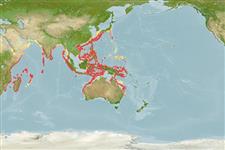Environment: milieu / climate zone / depth range / distribution range
Ecology
Marine; benthopelagic; depth range 135 - 540 m (Ref. 9784). Tropical; 36°N - 31°S, 34°E - 157°E (Ref. 6181)
Indo-West Pacific: off Mozambique, Kenya, Reunion, Saya de Malha Bank, north Australia, Indonesia, Viet Nam, Philippines, Ryukyu Islands, and southern Japan. Reported from Fiji and Tuvalu (Ref. 12596).
Size / Weight / Age
Maturity: Lm ? range ? - ? cm
Max length : 40.0 cm SL male/unsexed; (Ref. 6181)
Dorsal spines (total): 19 - 20; Dorsal soft rays (total): 14 - 17; Anal spines: 2; Anal soft rays: 12 - 15; Vertebrae: 34. Lateral line branching below the 4th to the 5th spine of the first dorsal fin; the upper branch reaching the middle to end of the second dorsal-fin base; the lower branch running mid laterally. Body naked except for a large scaly patch extending around the posterior portion of the lower lateral line. The pelvic fin is represented by a single spine in smaller specimens but is entirely absent in specimens over 18 - 20 cm SL. Body color is grayish with silvery tint; the fins hyaline except for the black blotch on the fin membranes between the first and the third first dorsal spines.
Feeds on fishes, crustaceans, and cephalopods (Ref. 5213, 9784). Utilized as a food fish food (Ref. 4537).
Life cycle and mating behavior
Maturities | Reproduction | Spawnings | Egg(s) | Fecundities | Larvae
Nakamura, I. and N.V. Parin, 1993. FAO Species Catalogue. Vol. 15. Snake mackerels and cutlassfishes of the world (families Gempylidae and Trichiuridae). An annotated and illustrated catalogue of the snake mackerels, snoeks, escolars, gemfishes, sackfishes, domine, oilfish, cutlassfishes,. scabbardfishes, hairtails, and frostfishes known to date. FAO Fish. Synop. 125(15):136 p. (Ref. 6181)
IUCN Red List Status (Ref. 130435)
Threat to humans
Harmless
Human uses
Fisheries: commercial
Tools
Special reports
Download XML
Internet sources
Estimates based on models
Preferred temperature (Ref.
123201): 11.2 - 19.8, mean 13.9 °C (based on 238 cells).
Phylogenetic diversity index (Ref.
82804): PD
50 = 0.5078 [Uniqueness, from 0.5 = low to 2.0 = high].
Bayesian length-weight: a=0.00363 (0.00163 - 0.00807), b=3.10 (2.91 - 3.29), in cm total length, based on LWR estimates for this (Sub)family-body shape (Ref.
93245).
Trophic level (Ref.
69278): 4.2 ±0.59 se; based on food items.
Resilience (Ref.
120179): Medium, minimum population doubling time 1.4 - 4.4 years (Preliminary K or Fecundity.).
Fishing Vulnerability (Ref.
59153): Moderate vulnerability (39 of 100).
Nutrients (Ref.
124155): Calcium = 78.4 [24.8, 245.7] mg/100g; Iron = 0.844 [0.259, 2.327] mg/100g; Protein = 15.9 [13.5, 18.8] %; Omega3 = 0.192 [0.102, 0.372] g/100g; Selenium = 97.2 [42.7, 206.7] μg/100g; VitaminA = 30.8 [9.4, 95.8] μg/100g; Zinc = 1.03 [0.71, 1.54] mg/100g (wet weight);
